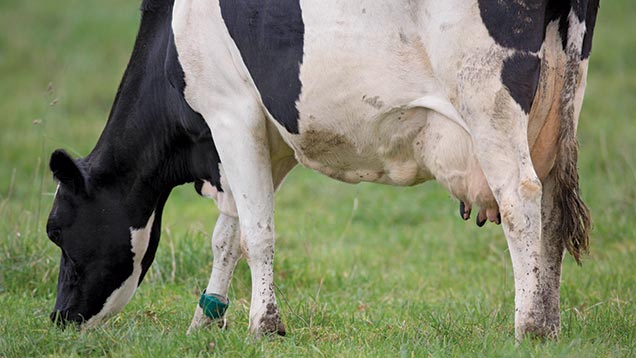Dairy farmers can use forage to reduce costs
 © Tim Scrivener
© Tim Scrivener All dairy farmers, irrespective of yield, have the potential to lower cost of production by increasing milk from forage, according to latest research.
An analysis of 50 herds benchmarked by Shropshire-based P&L Agri-Consulting between March 2013 and 2014, shows that cost of production (COP) decreased by 1p/litre for every extra 1,400 litres of milk produced from forage a hectare.
See also: Focus on milk from forage improves margins at Cheshire dairy
With the average COP at 30.01p/litre across the 50 farms, such savings will be crucial for those facing reduced returns, says P&L Agri consulting’s Sarah Harding.
Miss Hardman says the data clearly shows that most farms can address COP by paying closer attention to milk produced from forage a hectare.
“There was no correlation between yield and COP with some herds producing over 9,000 a litres a cow a year with COP in the top 25% and some herds under 5,500 litres a cow a year in the bottom 25%,” she says.
“However, there was a very strong correlation between yield from forage a hectare and COP with both high and low-yielding herds able to reduce costs by making better use of forage.”
In fact, many herds were able to produce over 8,500 litres a cow a year and still achieve over 6,500 litres from forage a hectare. This shows that high use of forage can be achieved even at high yields, says Miss Hardman.
She believes yield a forage hectare is a better indicator of efficiencies compared to milk from forage a cow as it gives an idea of how well land is being used.
Calculating yield a forage hectare is done by taking the milk from forage a cow a year x stocking rate.
She says all herds should be targeting at least 6,000 litres a ha or 3,000 litres a cow from forage.
But consultants say grazed grass has a key role to play in most systems in order to reduce costs.
“More intensive systems tend to spend more on feed, but analysis across systems showed for every additional 1p/litre spent on feed, the business also spent a further 0.6p/litre on associated costs such as machinery and labour,” says P&L Agri-consulting director Phil Clarke.
In fact, it is not until herd size increases to over 400 head and at yields exceeding 10,500 litres that these additional overheads are diluted, adds Mr Clarke.
He says this shows that any herd below this size and yield should be looking to use grazed grass to produce the majority of their summer milk.
“The lowest overhead costs per litre were seen on all-year-round calving systems that grazed all cows in the summer. They were able to maintain high yields in excess of 8,000 litres without the costs of housing all year round,” he adds.
